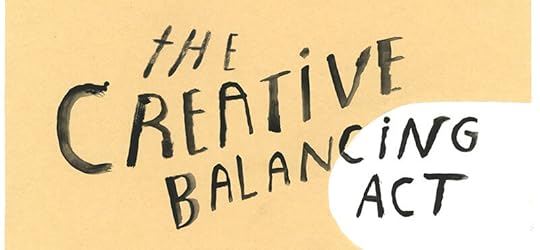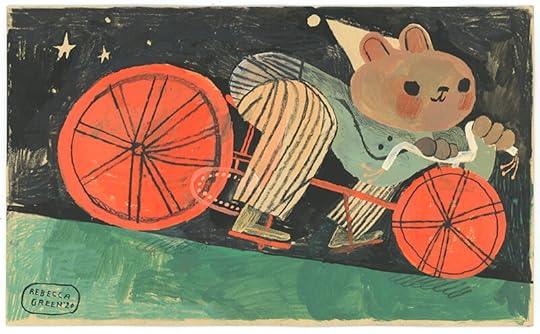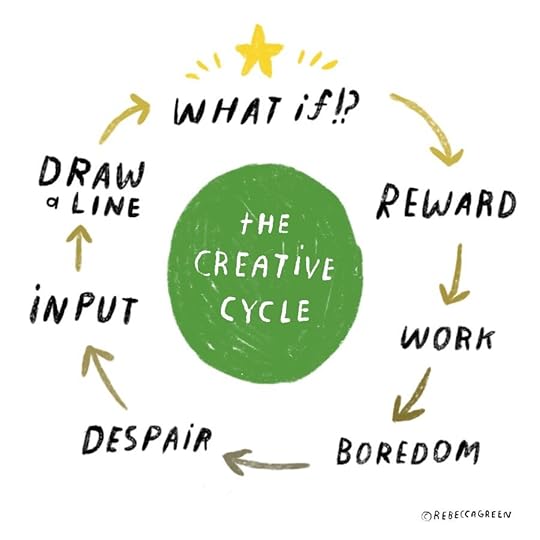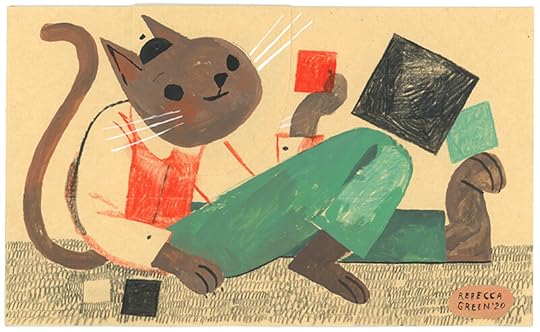The Creative Balancing Act

WELCOME WELCOME, step right up! Today we’re talking about balancing acts. Almost sounds like we’re going to the carnival. (Now I want funnel cakes!) Nope! But we are exploring a different kind of skillful balance trickery: being an illustrator!
While this post could seem somewhat sporadic, what I aim to communicate is the creative processes we experience as commercial artists. I’m breaking today’s posts down into four acts:
Juggling, Cycling, Blocks, & Balancing.
Ready? Get your french fries and vinegar! Funnel cakes! Popcorn! Into the tent we go!

ACT 1: JUGGLING
Art for money. Art for others. Art for us.
It’s all about keeping a balance of the three. In my illustration program, we never discussed balancing these factors but it was more like on the job training. As we navigate freelance illustration, we find a way to intuitively handle all the moving parts of the job. Every artist is different of course depending on their industry or goals.
Art for money.
We make art to make a living. Finding clients is obviously important, but finding the right clients is even better. In the beginning, it makes sense to say yes to every offer. Then, we learn to be discerning and say ‘no’. Too little client work is nerve wracking - besides the factor of income, it’s beneficial to collaborate and also have external pressure. Too much client work though, can diminish our time to play and experiment, thus producing a whole portfolio of work we don’t even recognize, or worse, like!
Art for others.
We make work to share. It’s rewarding when that work is well received by the industry or those around us. The flip side of that, is that whether we are influenced by strangers we admire, or those we’re close to, it can be confusing to parse out what we actually want to make vs what we think we should make. Sometimes this is direct: “Oh you’d be good at xyz, you should do that.” Or, a client may come to you with a moodboard of other artist’s work and the perimeters look slim. Other times, it’s more subconscious, “If I make a picture book, it should look the way others have done it.”
Art for us.
We make art because we’re artists. Why did we become illustrators? We might have loved the act of play, invention, problem solving, curiosity, patterns, story, etc. Sometimes the work we make for ourselves IS for other people. We may be propelled to create work for others in regards to environmental or racial justice issues. When I say art for ourselves, I mean the art that moves you - work you’d do if you never got paid a dime. If we don’t make personal work though, that impulse can be diminished and though it’s not gone forever, it can feel like a serious loss. On the other hand, if we make work we are truly impassioned with but can’t seem to earn an income from it, it can obviously cause major stress.
It’s no wonder the equilibrium is easily thrown off. Now, toss in more factors. Throw in running a business. Throw in taxes and contracts and promotion and marketing and making a website. Finally, throw in that pencil tip that keeps breaking every time you sharpen it! It’s maddening!
WOW this carnival got dark! You’re a terrible ringmaster Rebecca! I don’t share any of this to add worry, but more to affirm that if you ever feel stuck, frustrated, left out, uninspired, forgotten, confused, or angry in the process of illustrating, you are not alone. I cannot stress that enough. Juggling all of this is a lot, but it is doable. And it is such a rewarding profession.

ACT 2: cycling
The Creative cycle
The first time I learned about the creative process being cyclical, it was from a wise old professor. He asked about my plans after graduation and I told him I didn’t even want to think about art for a while. I felt guilty about it until he explained that creativity was a cycle like everything else in life. It made me feel a sense of stability like I could manage creativity - it wasn’t an elusive beast. Further in my career, I started to recognize my own patterns of working. The changing phases grew more familiar, almost comforting. It became easier to diminish the lamenting, let go of the struggle and as my friend Joe Kolean says, let it ride. It also reinforced that momentum begins by going back to the drawing board, not avoiding it. After some much needed inspiration of course.
While the creative cycle looks similar for most, it changes depending on the person.
My creative cycle looks something like this:

The best part is the WHAT IF. This is the aha! moment. The spark, the flow, the tingle. I then share my new creation - it gets a reaction, a REWARD. “They like me, they really like me!” This is fun, I’m glad I finally figured this whole illustration thing out. Someone then hires me. “Why yes, I will do this for WORK.” Oh no..now it’s actually feeling like work. I’m not really challenged any longer, but it seems to be doing the trick. Ugh this is no longer fun, why did I say yes to that project? I can’t handle the BOREDOM. I never want to make this again. Now I don’t know what to do. I enter the depths of motivationless DESPAIR. I’m worthless. I need to pay my bills. I’ll look up job boards. What am I doing?! I cry and lament to friends. Oh yeah, I probably just need INPUT. I go to a bookstore or somewhere new. Oooh I like that. That could be fun to draw. I drag myself back to my desk again to DRAW A LINE. At first it’s garbage so I draw another. Maybe another. OH this looks like something…yess….omg WHAT IF?!
When I first experienced the highs and lows, they seemed chaotic and permanent. A tingling AHA! moment was too wild to harness or trust. Conversely, a loss of motivation felt like the bitter end. During the lows or lulls, I sulked a lot. I napped and cried, felt lost, felt washed up. While those phases still happen, I now know how to approach them. Now, I am accepting and proactive (mostly!) Instead of lamenting for days on end, I understand it is part of the process. Lulls no longer mean utter defeat. They signal a need for rest and input. To refill my well, I ask myself, “What am I curious about? What would be fun?” Often the answers are things like cooking, hiking, thifting, dancing, or visiting a bookstore. Once I’ve had some time out of my own head, I’m more likely to have a spark of inspiration that sends me back to the drawing board, thus propelling me towards the ever sacred tingle. (Should I stop calling it that?!) I’m now learning to trust that tingle.
Curious about your own creative cycle? Try to identify patterns. Pay attention to how you’re approaching your work or creativity. Are you full and inspired? Are you depleted and low? Once we know more about ourselves as artists, it becomes easier to *almost* enjoy the rollercoaster that is the creative cycle.

ACT 3: BLOCKS
Creative Blocks vs. Creative Burnouts
I’ve heard the terms creative block and creative burnout interchanged. Having experienced both, I feel they are quite different. Let’s explore some possible causes and hopeful solutions so you can figure out the problem, pick yourself back up and get to creating again. Also obviously I’m not a creative philosopher, therapist, or specialist, but just one artist sharing her experience.
CREATIVE BLOCK
Are creative blocks real? I’ve heard arguments on both sides. It’s true, relative to the harshness of life, how can anyone lament painting? On the other hand, I’ve felt the deep woes of creative frustration. Here’s where I stand: creative blocks arise, but instead of focusing on whether or not it’s actually an obstacle, it’s best to focus on the solution. Do not let it be an excuse for a continual refusal to show up.
Causes of a creative block:
Fear
Making art is vulnerable and scary! We can be deeply afraid we’ll come up empty handed, revealing how lacking we think we are. Much safer to avoid it, thinking, “I could make that…but not right now.”
Boredom
We need a balance of challenge and mastery. If work becomes predictable and comfortable, it’s no longer fun. We run on autopilot which is never enticing.
Intimidation
A little different than fear in that it’s more technical. Maybe we don’t have the technical skill so we avoid the process, even though practice leads to skill. It’s also intimidating if our options are limitless.
Shoulds
I have the word should on my studio wall with a big red X through it. We can feel debilitated by the result before we even start the process. Either we’re already bored by it, or it’s too elusive.
Solutions for a creative block:
Begin
We think it has to be more complicated but often it isn’t. Want a place to begin? Draw your kitchen. Draw your dog. Throw a blob of paint on a piece of paper and see what it looks like. Momentum is built, it doesn’t appear out of nowhere.
Circumnavigate
Blank paper is scary. What about that gross scrap paper on the floor? Make something on that. I often make my best work on scraps as the final paper is too precious. Also, you can dodge your inner critic by assuring them that the thing you’re about to making doesn’t count.
Limitation
Limit yourself to two tools. Two colors. Maybe a specific size. Put a bunch of words in a jar and pick one. Draw that and no cheating. We need boundaries to spark problem solving.
What If?
Replace should with what if. Instead of asking '“What should I make?” Instead, try saying: “What if I made….” More ideas arise when the question is posed as a possibility.
CREATIVE BURNOUT
Back in 2018, I shared a long blog post on creative burnout. In it, I wrote, “If a creative block is a rainstorm, a burnout is a hurricane (and you're out at sea, alone.)” I had never had something quite as dramatic prior to, nor since, and I hope I never do again. A creative block is more of an aversion to starting, but a creative burnout comes from the inability to say no. It’s a result of ignoring your physical or mental boundaries in regards to producing.
Causes of creative burnout:
Overload
Saying yes to too many things, whether in life, work, or relationships. As freelancers, it’s easy to say yes to everything and be ‘on’ all the time.
Disregard
If you continually ignore signs that you’re physically or mentally stressed, you can simply break under the weight. Leading up to my creative burnout, I ignored warning signs. My upper back, chest, and neck became extremely tight. I couldn’t get a deep enough breath and I broke out in a rash on my neck. I wept at my drawing desk and I screamed on my way to work just to feel a release of tension.
Force
If you need to rest, fill up your tank, or gather input yet you force your way through producing again and again - eventually you can experience burnout.
Solutions for a creative burnout:
Rest
You may need a serious break. There’s nothing wrong with finding a different income source to ensure stability while freeing your mind from creative pressure. Sometimes, just a week or two can do wonders. I know stress is glamorized to a certain extent but know that ease and a steady workflow are much more likely to lead to a long and sustainable career.
Curiosity
Stay curious, take time to explore something completely different from your norm. This past year I took singing lessons and it was amazing what learning a new skill can do. Try to dig into other parts of yourself that maybe you’ve neglected because they seemed too indulgent.
Acceptance
The last thing you need is to add stress by feeling angry at yourself. Understand that it is temporary, no matter how painful it feels. From my own experience, bouncing back from a burnout isn’t a lightswitch moment. It could take months of showing up, seeking joy, allowing the ground to shift, and finding a new and more sustainable workflow.

Take care of yourself. Take care of your work.
The final act of our show! It always feel like a balancing act to keep up with life and work (and I don’t even have kids! How do you do it!?) I wanted to leave with you with a couple tips that have helped me stay motivated, focused, or inspired.
PERSONAL DAYS
I highly suggest choosing a day of the week (even just an afternoon) and dedicating it to personal work. This work is not for sharing - not right away anyway. Make something you’re too frightened to make. Play with a new material. Test out some techniques you’ve been wanting to try.
LEARN
Take a class. Find a free tutorial to start something new. Try your hand at a new art form even if you don’t plan on using it right away. Learning keeps our brains fresh and humble.
CARE FOR YOUR BODY
Go for a walk, dance, run, or do yoga (I love Yoga with Adriene, it’s free!) Eat some plants. Get enough sleep. We are nothing without our health. I’m not exactly a pinnacle of healthy living, but I’ve learned a lot in the last decade. I didn’t grow up taking care of my body. I never worked out, I survived on tater tots and hot pockets and I smoked til I was like 24. And it’s A-OK if that sounds like you and you’re happy. But taking care of my body has helped me mentally - and I need my mind for work!
SET A TIMER
Last year, I took Lisa Congdon’s Time Management class and it really changed the way I set up my work schedule. One of the biggest take-aways was setting a timer and putting away distractions so I could work in focused increments.
TAKE BREAKS
Taking little brain breaks between your focused work time is really healthy for your workflow. Don’t use it to check email - use it to take deep breaths or walk outside. Use it to eat chocolate or pet your dog. It’ll make powering through a long day much easier.
THAT my friends, is a wrap! if you made it this far, I applaud YOU! Thanks for reading, for showing up, for continuing to make the world better with your work. And remember - this is a wild year. Take care of your creative self!
Now go out (masked of course) and celebrate September! We’re about to make boat loads of apple crumble and bust into some scary movies soon. I love Autumn!
Until next time,
Becca
Rebecca Green's Blog
- Rebecca Green's profile
- 80 followers



